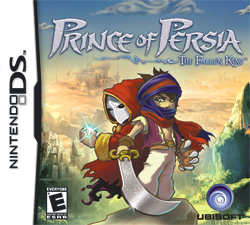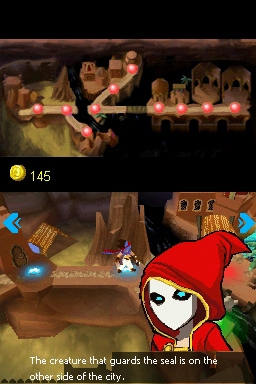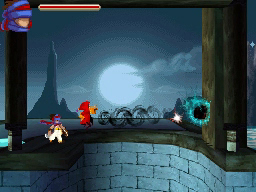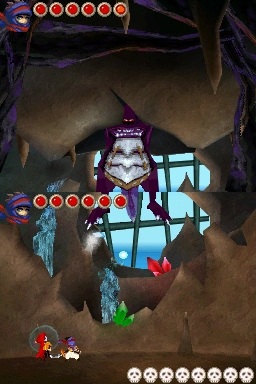|
|
 |
The Fallen King falls into the world of the recent Prince of Persia for Xbox 360 and Playstation 3. Corruption has taken over the land, and the Prince is working to rid the world of it. He ventures to meet a King whom he believes can help, only to find him
 |
The game starts out quite strong, with the stylus being your guiding rod. To move right, the stylus is held down to the Prince's right. To jump, just touch the platform and the Prince will automatically jump to it. This same basic scheme applies to all of the acrobatic moves the game provides to the player, from wall jumping to pole swinging. For the first little while the controls work quite well, and help to make the game move smoothly.
Not long into the adventure, upon teaming up with The Magus, the Prince gains an ability or two, with more being introduced as the game moves along. There are free orbs of corruption hanging around the environment which can be zipped to, and other orbs which can be used as explosive. Corruption can be formed into solid walls to continue the platforming, or to build bridges to span gaps. This is where the development starts to falter.
To create bridges and walls with corruption, it must be dragged across the screen with the stylus, then solidified by rubbing on it. It doesn't work, and is an exercise in
 |
Mixed in with the platforming is combat. Throughout the game there are three different enemy types the Prince will bump into. Normal, Strong, and Flying. That's it for the whole game. They don't even change colours from level to level. For the normal ones a quick stylus tap on them will attack, a tap on the Prince will block, and that's the combat. The strong ones need to have a shield pulled away from them first, and are then normal. This breaks combat into attack, attack, block. There aren't any other options. More than two attacks, and the enemy will land a hit, guaranteed. Theoretically there's a strong attack but there's no time in combat to pull the move off.
Whilst jumping around the levels there are different articles and chests to collect. The items can be money or extra health. These might have added some replay value, had the player been able to jump back to previous levels in the game. Instead, once a world has been defeated it can not be returned to.
 |
The Fallen King takes after New Super Mario Bros. visually, with the gameplay in strict 2D while everything in the game world is 3D. The look just does not fit, and everything ends up feeling flat and lacking detail. While possibly unpopular, sprites may have been a better option as some detail could have been shown. The game also has some slowdown later on, when battles occur. As far as the music and sound go, it's all standard fare. Everything works just fine, but really, the game should have had voice acting.
In the end, the controls really leaves Prince of Persia: The Fallen King bruised, battered, and broken. When the controls work, it can actually be fun to swing around the levels on the DS, but unfortunately the touch implementation fails the player too often. If everything had run perfectly I could have imagined enjoying the platforming, though the boss battles and combat still would have been worthless. But in a rush to get this out for holiday 2008, and alongside its big brother, the game's quality suffers in too large a way to recommend.
Skip It
© Copyright 2002-2019 by Toon Doctor Inc. - All rights Reserved. All other texts, images, characters and trademarks are copyright their respective owners. Use of material in this document (including reproduction, modification, distribution, electronic transmission or republication) without prior written permission is strictly prohibited.

